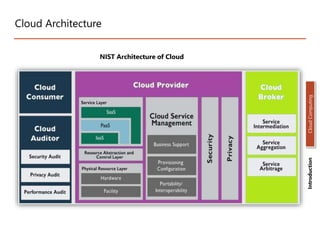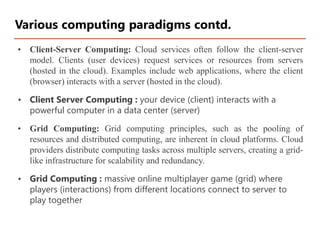Ad
cloudintro-lec018.1.ppt
- 1. Cloud Computing BCA-604 (a) Programme: BCA Course: Cloud Computing By Dr. Chandani Sharma Associate Professor, MMICT&BM M.M.(Deemed to be University) UNIT 1 Section- A (Cloud Computing)
- 2. Introduction What is cloud computing? Cloud computing refers to the delivery of computing services over the internet, including storage, processing power, and software applications. Cloud computing is like renting the computing power and storage you need, when you need it, without worrying about the complexities of building and maintaining the underlying infrastructure. Introduction Cloud Computing It allows users to access resources and services on-demand, without the need for physical infrastructure or local servers.
- 3. Characteristics of Cloud Computing Key Characteristics of Cloud Computing • On-Demand Self-Service: Users can provision resources and services as needed, without requiring human interaction with service providers. • Broad Network Access: Services are accessible over the internet via standard protocols and devices. • Resource Pooling: Computing resources are pooled together to serve multiple users, allowing for efficient utilization and scalability. • Rapid Elasticity: Resources can be scaled up or down quickly to meet changing demands. • Measured Service: Cloud service usage is measured, monitored, and billed based on actual consumption. • Service Models : IaaS, PaaS, SaaS • Deployment Models : public, private, hybrid, community • Security & Reliability Introduction Cloud Computing
- 5. Cloud Deployment Models Public Cloud • Services are provided over a public network and available to anyone who wants to use them. • It is a cost-effective option for businesses and individuals looking for scalability and flexibility. • Public cloud providers, such as AWS, Azure, and GCP, offer a wide range of services accessible to the general public. Introduction Cloud Computing
- 6. Cloud Deployment Models Private Cloud • Infrastructure is dedicated to a single organization and may be located on-premises or off- premises. • Private cloud environments are designed to meet specific security, compliance, or performance requirements. • They offer enhanced control, customization, and privacy but require significant upfront investment. Introduction Cloud Computing
- 7. Cloud Deployment Models Hybrid Cloud • Combines public and private cloud environments, allowing for flexibility and data sharing between the two. • Organizations can leverage the benefits of both public and private clouds, ensuring optimal resource allocation. • Hybrid cloud deployments enable workload portability and seamless integration between different environments. Introduction Cloud Computing
- 8. Cloud Deployment Models Community Cloud • Community cloud is a deployment model where infrastructure and services are shared among a specific community or group of organizations. • It caters to the needs of a particular community, such as government agencies, educational institutions, or research organizations. • Community cloud provides a cost- effective solution while addressing specific requirements and compliance standards of the community. Introduction Cloud Computing
- 9. Service Models Infrastructure as a Service (IaaS) IaaS provides virtualized computing resources over the internet. Users have control over the operating systems, storage, and networking components. They can provision and manage virtual machines (VMs), storage, and networks according to their requirements. Examples of IaaS providers include AWS EC2, Azure Virtual Machines, and Google Compute Engine. Introduction Cloud Computing
- 10. Service Models Platform as a Service (PaaS) PaaS offers a platform for developing, testing, and deploying applications. Users can focus on application development without worrying about infrastructure management. PaaS providers manage the underlying infrastructure, including servers, storage, and networking. Developers can leverage pre-configured environments, development frameworks, and deployment tools. Examples of PaaS providers include Heroku, Google App Engine, and AWS Elastic Beanstalk. Introduction Cloud Computing
- 11. Service Models Software as a Service (SaaS) SaaS delivers software applications over the internet on a subscription basis. Users can access and use applications directly through a web browser or APIs. The provider hosts and manages the underlying infrastructure, application, and data. Users can typically customize certain aspects of the application to fit their needs. Examples of SaaS include Salesforce, Microsoft Office 365, and Google Workspace. Introduction Cloud Computing
- 12. Benefits of Cloud • Cost Savings: Pay for what you use, with no upfront infrastructure costs. • Scalability: Easily scale resources up or down based on demand. • Flexibility: Access resources and applications from anywhere with an internet connection. • Reliability: Cloud providers typically offer high uptime and data redundancy. • Collaboration: Enable seamless collaboration and data sharing among teams. Introduction Cloud Computing
- 13. Common Cloud Computing Use Cases • Data Storage and Backup: Store and back up large amounts of data securely. • Software Development and Testing: Rapidly create and deploy applications in a scalable environment. • Web and Mobile Applications: Host web and mobile applications in the cloud for global accessibility. • Big Data Analytics: Process and analyze vast amounts of data using cloud resources. • Disaster Recovery: Maintain data backups and recovery plans in the cloud for business continuity. Introduction Cloud Computing
- 14. Cloud Architecture • Cloud architecture refers to the design and structure of cloud computing environments, including the arrangement of components and the relationships between them. • It involves various elements that work together to deliver cloud services and ensure reliability, scalability, and security. Introduction Cloud Computing
- 16. Explanation Contd… • Cloud Consumer: An individual or organization that engages in a business partnership with Cloud Providers and utilizes their services. • Cloud Provider: A person, organization, or entity that is accountable for offering services to individuals or entities who are interested in them. • Cloud Auditor: A party capable of conducting an impartial evaluation of cloud services, as well as assessing the performance, security, and operations of the cloud implementation. • Cloud Broker: An entity responsible for managing the utilization, performance, and delivery of cloud services. Additionally, they act as mediators between Cloud Providers and Cloud Consumers, negotiating relationships between the two parties. • Cloud Carrier: An intermediary that facilitates the connectivity and transportation of cloud services from Cloud Providers to Cloud Consumers. Introduction Cloud Computing
- 17. Cloud Architecture Best Practices • Up-front Planning: Prioritize up-front planning to understand capacity needs and avoid unexpected production glitches. Continuously test performance during the architecture design phase. • Security First: Implement robust security measures to protect against unauthorized access. Safeguard all layers of the cloud infrastructure through data encryption, patch management, and strict security policies. Consider adopting zero-trust security models for enhanced protection in hybrid and multi-cloud environments. • Disaster Recovery Readiness: Automate recovery processes to minimize costly downtime and ensure swift recovery from service disruptions. Implement monitoring mechanisms to track capacity and utilize redundant networks for a highly available architecture. • Maximize Performance: Optimize computing resources by continuously monitoring business demands and technological requirements. Efficiently manage and allocate resources to maintain optimal performance levels. • Cost Optimization: Leverage automated processes, managed service providers, and utilization tracking to reduce unnecessary cloud computing expenses. Regularly review and optimize resource allocation to ensure cost-effectiveness. Introduction Cloud Computing
- 18. Remember • Understand your specific needs and requirements when selecting a cloud deployment and service model. • Prioritize security measures such as data encryption and access controls to protect against unauthorized access. • Plan for disaster recovery and high availability to ensure business continuity. • Continuously monitor and optimize resource utilization for optimal performance and cost savings. • Regularly assess and adapt your cloud architecture to evolving business needs and emerging technologies. Introduction Cloud Computing
- 19. • Multitasking: Cloud platforms support multitasking by allowing multiple users or applications to run concurrently on shared resources. Virtualization technologies enable the efficient allocation of resources to multiple tasks. • Multitasking : cloud-based word processor • Multiprocessing: Cloud environments leverage multiprocessor architectures to handle multiple tasks simultaneously. This contributes to improved performance and responsiveness, especially in scenarios where parallel processing is beneficial. • Multiprocessing : (processor) can handle a different request from users • Virtualization: Virtualization is a fundamental technology in cloud computing. It allows the creation of virtual instances of computing resources, such as virtual machines (VMs) or containers, which can be dynamically allocated and managed. • Virtualization: multiple virtual machines to run on the same physical server Various computing paradigms
- 20. • Utility Computing: Cloud services operate on a utility computing model, where users pay for the computing resources they consume. It's analogous to utilities like electricity, where users are billed based on usage rather than owning the infrastructure. • Utility Computing: pay for computing resources (storage, processing power) • Cluster Computing: Cloud providers often use clusters of servers to deliver scalable and high-performance computing. Clusters enable efficient resource utilization and workload distribution. • Cluster Computing: cluster of servers collaborates to manage heavy workloads • Distributed Computing: Cloud computing inherently involves distributed computing. Resources are distributed across multiple servers and data centers, allowing for improved performance, fault tolerance, and scalability. • Distributed Computing: project mates share updates through a cloud platform Various computing paradigms contd.
- 21. • Parallel Computing: Cloud platforms support parallel computing through the use of parallel processing techniques, allowing the simultaneous execution of tasks across multiple processors or servers. • Parallel Computing: parallel processing involves multiple processors • Collaborative Computing: Cloud services facilitate collaborative computing by providing tools and platforms that enable users to work together in real-time. Examples include collaborative document editing or project management tools. • Collaborative Computing: working on a shared document online simultaneously • Peer-to-Peer Computing: While traditional peer-to-peer architectures involve direct communication between peers, cloud platforms often utilize a hybrid approach. Peer- to-peer file sharing or content distribution may be facilitated through cloud-based servers. • Peer to Peer Computing: users share music directly with each other, without a central server Various computing paradigms contd.
- 22. • Client-Server Computing: Cloud services often follow the client-server model. Clients (user devices) request services or resources from servers (hosted in the cloud). Examples include web applications, where the client (browser) interacts with a server (hosted in the cloud). • Client Server Computing : your device (client) interacts with a powerful computer in a data center (server) • Grid Computing: Grid computing principles, such as the pooling of resources and distributed computing, are inherent in cloud platforms. Cloud providers distribute computing tasks across multiple servers, creating a grid- like infrastructure for scalability and redundancy. • Grid Computing : massive online multiplayer game (grid) where players (interactions) from different locations connect to server to play together Various computing paradigms contd.
- 23. THANK YOU






































































